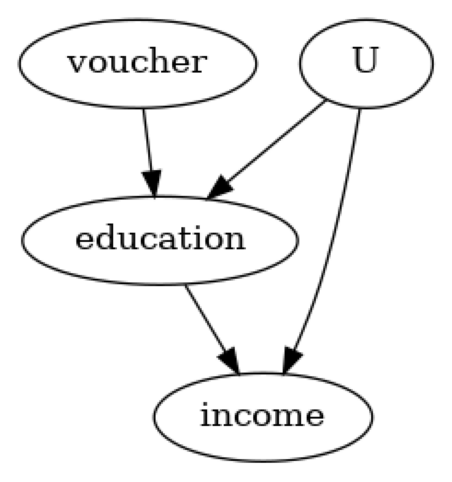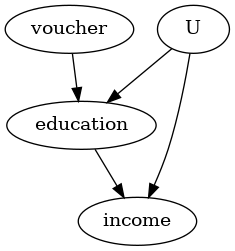使用工具变量方法进行估计的简单示例#
[1]:
%load_ext autoreload
%autoreload 2
[2]:
import numpy as np
import pandas as pd
import patsy as ps
from statsmodels.sandbox.regression.gmm import IV2SLS
import os, sys
from dowhy import CausalModel
加载数据集#
我们创建了一个虚构的数据集,目的是估计教育对个人未来收入的影响。个人的ability是一个混杂因素,而获得education_voucher是工具变量。
[3]:
n_points = 1000
education_abilty = 1
education_voucher = 2
income_abilty = 2
income_education = 4
# confounder
ability = np.random.normal(0, 3, size=n_points)
# instrument
voucher = np.random.normal(2, 1, size=n_points)
# treatment
education = np.random.normal(5, 1, size=n_points) + education_abilty * ability +\
education_voucher * voucher
# outcome
income = np.random.normal(10, 3, size=n_points) +\
income_abilty * ability + income_education * education
# build dataset (exclude confounder `ability` which we assume to be unobserved)
data = np.stack([education, income, voucher]).T
df = pd.DataFrame(data, columns = ['education', 'income', 'voucher'])
使用DoWhy估计教育对未来收入的因果效应#
我们遵循以下四个步骤:1)使用因果图对问题进行建模,
识别是否可以从观察到的变量中估计因果效应,
估计效果,并且
检查估计的稳健性。
[4]:
#Step 1: Model
model=CausalModel(
data = df,
treatment='education',
outcome='income',
common_causes=['U'],
instruments=['voucher']
)
model.view_model()
from IPython.display import Image, display
display(Image(filename="causal_model.png"))
/__w/dowhy/dowhy/dowhy/causal_model.py:583: UserWarning: 1 variables are assumed unobserved because they are not in the dataset. Configure the logging level to `logging.WARNING` or higher for additional details.
warnings.warn(


[5]:
# Step 2: Identify
identified_estimand = model.identify_effect(proceed_when_unidentifiable=True)
print(identified_estimand)
Estimand type: EstimandType.NONPARAMETRIC_ATE
### Estimand : 1
Estimand name: backdoor
No such variable(s) found!
### Estimand : 2
Estimand name: iv
Estimand expression:
⎡ -1⎤
⎢ d ⎛ d ⎞ ⎥
E⎢──────────(income)⋅⎜──────────([education])⎟ ⎥
⎣d[voucher] ⎝d[voucher] ⎠ ⎦
Estimand assumption 1, As-if-random: If U→→income then ¬(U →→{voucher})
Estimand assumption 2, Exclusion: If we remove {voucher}→{education}, then ¬({voucher}→income)
### Estimand : 3
Estimand name: frontdoor
No such variable(s) found!
[6]:
# Step 3: Estimate
#Choose the second estimand: using IV
estimate = model.estimate_effect(identified_estimand,
method_name="iv.instrumental_variable", test_significance=True)
print(estimate)
*** Causal Estimate ***
## Identified estimand
Estimand type: EstimandType.NONPARAMETRIC_ATE
### Estimand : 1
Estimand name: iv
Estimand expression:
⎡ -1⎤
⎢ d ⎛ d ⎞ ⎥
E⎢──────────(income)⋅⎜──────────([education])⎟ ⎥
⎣d[voucher] ⎝d[voucher] ⎠ ⎦
Estimand assumption 1, As-if-random: If U→→income then ¬(U →→{voucher})
Estimand assumption 2, Exclusion: If we remove {voucher}→{education}, then ¬({voucher}→income)
## Realized estimand
Realized estimand: Wald Estimator
Realized estimand type: EstimandType.NONPARAMETRIC_ATE
Estimand expression:
⎡ d ⎤
E⎢────────(income)⎥
⎣dvoucher ⎦
──────────────────────
⎡ d ⎤
E⎢────────(education)⎥
⎣dvoucher ⎦
Estimand assumption 1, As-if-random: If U→→income then ¬(U →→{voucher})
Estimand assumption 2, Exclusion: If we remove {voucher}→{education}, then ¬({voucher}→income)
Estimand assumption 3, treatment_effect_homogeneity: Each unit's treatment ['education'] is affected in the same way by common causes of ['education'] and ['income']
Estimand assumption 4, outcome_effect_homogeneity: Each unit's outcome ['income'] is affected in the same way by common causes of ['education'] and ['income']
Target units: ate
## Estimate
Mean value: 4.0206040845835105
p-value: [0, 0.001]
我们有一个估计,表明将education增加一个单位会使income增加4个点。
接下来,我们使用安慰剂反驳测试来检查估计的稳健性。在这个测试中,治疗被一个独立的随机变量所取代(同时保持与工具的关联),因此真实的因果效应应该为零。我们检查我们的估计器是否也提供了零的正确答案。
[7]:
# Step 4: Refute
ref = model.refute_estimate(identified_estimand, estimate, method_name="placebo_treatment_refuter", placebo_type="permute") # only permute placebo_type works with IV estimate
print(ref)
Refute: Use a Placebo Treatment
Estimated effect:4.0206040845835105
New effect:0.07846773265599782
p value:0.72
反驳使我们有信心估计没有捕捉到数据中的任何噪声。
由于这是模拟数据,我们也知道真实的因果效应是 4(参见上面数据生成过程的 income_education 参数)
最后,我们通过另一种方法展示相同的估计,以验证来自DoWhy的结果。
[8]:
income_vec, endog = ps.dmatrices("income ~ education", data=df)
exog = ps.dmatrix("voucher", data=df)
m = IV2SLS(income_vec, endog, exog).fit()
m.summary()
[8]:
| 因变量: | income | R平方: | 0.892 |
|---|---|---|---|
| 模型: | IV2SLS | 调整后的R平方: | 0.892 |
| 方法: | 两阶段 | F统计量: | 1528. |
| 最小二乘法 | Prob (F统计量): | 1.93e-203 | |
| 日期: | 2024年11月24日,星期日 | ||
| 时间: | 18:03:48 | ||
| 观测数量: | 1000 | ||
| 自由度残差: | 998 | ||
| 自由度模型: | 1 |
| 系数 | 标准误差 | t值 | P>|t| | [0.025 | 0.975] | |
|---|---|---|---|---|---|---|
| 截距 | 10.0485 | 0.957 | 10.504 | 0.000 | 8.171 | 11.926 |
| 教育 | 4.0206 | 0.103 | 39.086 | 0.000 | 3.819 | 4.222 |
| 综合统计量: | 1.426 | 杜宾-沃森统计量: | 1.933 |
|---|---|---|---|
| 概率(Omnibus): | 0.490 | Jarque-Bera (JB): | 1.446 |
| 偏度: | -0.092 | JB概率: | 0.485 |
| 峰度: | 2.966 | 条件数 | 26.7 |